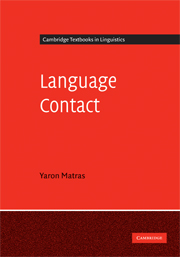Book contents
- Frontmatter
- Contents
- List of figures
- Preface
- List of abbreviations
- 1 Introduction
- 2 An emerging multilingual repertoire
- 3 Societal multilingualism
- 4 Acquiring and maintaining a bilingual repertoire
- 5 Crossing the boundaries: codeswitching in conversation
- 6 The replication of linguistic ‘matter’
- 7 Lexical borrowing
- 8 Grammatical and phonological borrowing
- 9 Converging structures: pattern replication
- 10 Contact languages
- 11 Outlook
- Notes
- References
- Author index
- Language index
- Subject index
4 - Acquiring and maintaining a bilingual repertoire
Published online by Cambridge University Press: 05 June 2012
- Frontmatter
- Contents
- List of figures
- Preface
- List of abbreviations
- 1 Introduction
- 2 An emerging multilingual repertoire
- 3 Societal multilingualism
- 4 Acquiring and maintaining a bilingual repertoire
- 5 Crossing the boundaries: codeswitching in conversation
- 6 The replication of linguistic ‘matter’
- 7 Lexical borrowing
- 8 Grammatical and phonological borrowing
- 9 Converging structures: pattern replication
- 10 Contact languages
- 11 Outlook
- Notes
- References
- Author index
- Language index
- Subject index
Summary
Bilingual first-language acquisition
In Chapter 2 we followed the emergence of a bilingual repertoire. We witnessed a process of complex linguistic socialisation whereby the child speaker learns to comply with adult interlocutor expectations regarding the selection of structures in particular contexts. This process also gives rise to the more systematic and conventionalised mapping of sets of structures – the bilingual's ‘languages’ – onto sets of social activities, a mapping which in turn is anchored in the kind of multilingual reality as discussed in Chapter 3. The present section reviews key issues in the study of the acquisition of bilingual repertoires.
Definitions and methodological problems
The term ‘bilingual’ is often associated with the ability to use each language at a level of proficiency that equals that of monolingual speakers. This ability is sometimes captured more specifically in the notion of a ‘balanced bilingual’. There is however consensus that bilinguals are not simply the sum of two monolinguals in one (cf. Grosjean 1989, De Houwer 1990: 339, Bauer, Hall, and Kruth 2002). Firstly, bilingual speakers may have certain preferences or patterns of dominance of one language over another in particular contexts. Second, bilinguals have, in addition to the ability to sustain monolingual conversations, also an important additional resource at their disposal, namely the ability to contrast languages in conversation. Interpreting the position and the functional value of language ‘mixing’ is crucial, as we shall see, in understanding the bilingual acquisition process.
- Type
- Chapter
- Information
- Language Contact , pp. 61 - 100Publisher: Cambridge University PressPrint publication year: 2009



